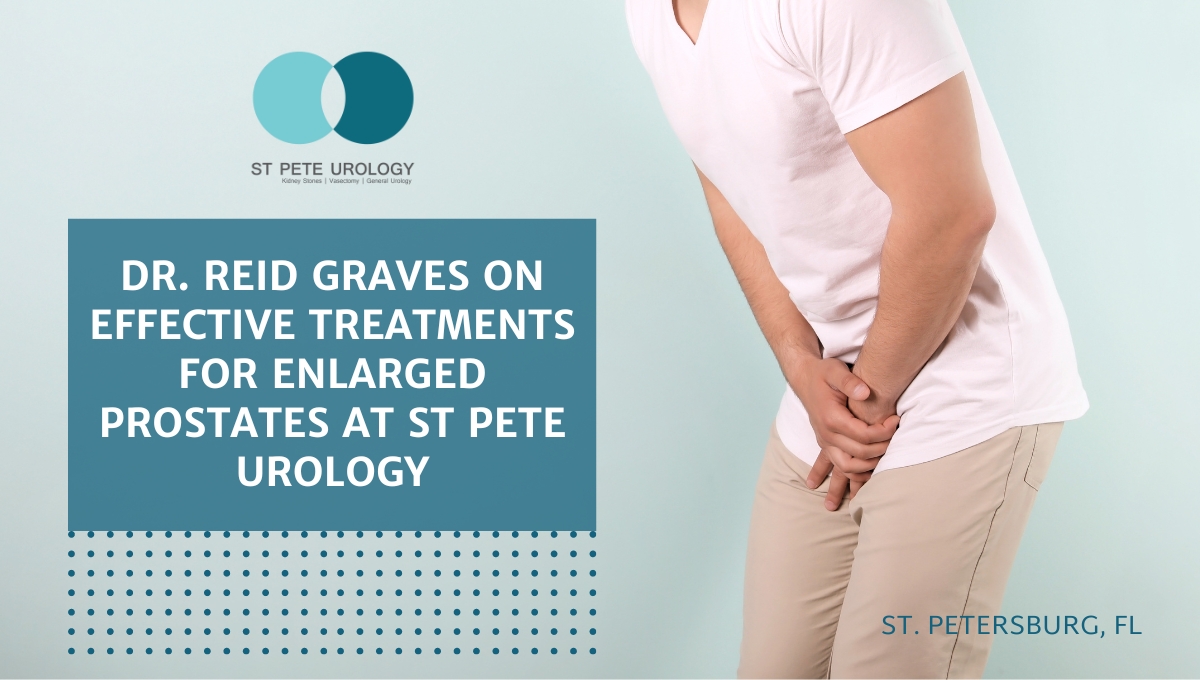Key Takeaways:
- Treatments for enlarged prostates require careful consideration of various factors to create a personalized treatment plan.
- TURP and GreenLight laser treatments are effective methods of managing an enlarged prostate.
- St Pete Urology provides expert care and quick recovery times for prostate enlargement treatments.
As men age, they may face the common yet uncomfortable issue of prostate enlargement. In St. Petersburg, FL, there’s a urologist who understands the intricacies of this condition – Dr. Reid Graves of St Pete Urology. In his words, “One of the things we take pride in here at St. Pete Urology is the management of patients with enlarged prostates.” So, what makes his approach so effective? Let’s dive in and explore Dr. Graves’ effective treatments of enlarged prostates.
Determining the Best Treatment
Treating an enlarged prostate isn’t a one-size-fits-all approach. Instead, it requires careful consideration of various factors. These factors include the patient’s overall health, comorbid conditions, and potential complications from blood thinners, as explained by Dr. Graves. The goal, of course, is to create a personalized treatment plan that best suits each patient’s needs.
TURP and GreenLight Laser: Two Effective Treatment Options
There are many different treatment options available for managing an enlarged prostate. Two of the most effective methods, according to Dr. Graves, are TURP (transurethral resection of the prostate) and GreenLight laser prostatectomy.
TURP involves the use of a hot knife that is inserted through the urethra to cut out pieces of tissue from the prostate. This procedure can be invasive, but it often produces excellent results for patients with severe urinary symptoms or obstruction.
Alternatively, Dr. Graves also recommends the GreenLight laser prostatectomy. This procedure is unique because the laser used is absorbed by hemoglobin in the blood. This minimizes blood loss during surgery. Interestingly, Dr. Graves can perform this treatment on patients taking blood thinners. This makes it a versatile option for many men dealing with prostate enlargement.
The “Apple Core” Analogy
To help his patients understand the goals of these treatments, Dr. Graves uses the analogy of an apple. Imagine the prostate as an apple, and the core is the part where urine travels through. In order to improve a patient’s ability to urinate, the “apple core” must be removed to create more space for the urine to pass. Both TURP and GreenLight laser procedures can effectively achieve this goal by removing excess tissue from the prostate with precision and care.
Quick Recovery Times
One of the most striking aspects of Dr. Graves’ treatment methods is the speedy recovery time. With the GreenLight laser prostatectomy, patients can expect to have their catheter removed the day after the procedure, and it could even be a same-day surgery. This quick turnaround allows men to return to their regular activities with minimal disruption, making it an attractive option for those seeking relief from their prostate enlargement symptoms.
Choose St Pete Urology for Expert Care
If you or a loved one are dealing with the challenges of prostate enlargement, it’s crucial to find a skilled and compassionate urologist who will prioritize your needs and well-being. In St. Petersburg, FL, Dr. Reid Graves and the team at St Pete Urology are known for their dedication to providing the highest level of care to patients facing this common yet complex condition. Don’t leave your health in the hands of just anyone – trust the experience and expertise of St Pete Urology to guide you toward the most effective treatments for enlarged prostates.
References:
- “Transurethral Resection of the Prostate (TURP).” https://www.hopkinsmedicine.org/health/treatment-tests-and-therapies/transurethral-resection-of-the-prostate-turp.
- “What Is A GreenLight Laser Prostatectomy? | QProstate.” https://qprostate.com.au/greenlight-laser-prostatectomy/greenlight-laser-prostatectomy/.
- “Enlarged Prostate (BPH) – Symptoms and Causes – Penn Medicine.” https://www.pennmedicine.org/for-patients-and-visitors/patient-information/conditions-treated-a-to-z/enlarged-prostate.
Transcription:
My name is Reid Graves and I’m a urologist at St Pete Urology. One of the things we take pride in here at St. Pete Urology is the management of patients with enlarged prostates. This is a very common problem as men age and oftentimes people will have difficulty urinating. If their symptoms are significant enough or they’re unable to urinate, oftentimes a surgery will be indicated. Determining which surgery is right for the patient depends on a variety of factors including their comorbid conditions, their health, and if they’re on any blood thinners. Some of the options include a TURP or transurethral resection of the prostate in which a hot knife is used through the urethra in order to cut out the pieces of the tissue in the prostate.
Another option is to use the GreenLight laser to perform a GreenLight laser prostatectomy. This laser is unique because the laser is absorbed by hemoglobin which is in the blood. This provides the patient with minimal blood loss during the procedure and we’re actually able to perform these procedures in patients that are on blood thinners. Essentially when patients have enlarged prostates, the prostate is like an apple. The apple core is the part where the urine travels through the apple. In order for us to allow patients to urinate better, we use our instruments to remove the apple core from the apple so that the urine can flow through the apple. We can use the GreenLight laser to perform this with a same day procedure or at the most patients will stay overnight one day and then we will remove their catheter the following day.


